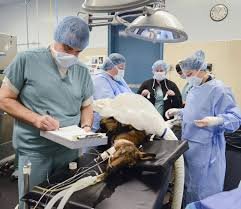Guest Book
Dr. Soorydas S,
16 - Jun - 2016
A PROTOCOL FOR GENERAL ANAESTHESIA IN GOATS

A PROTOCOL FOR GENERAL ANAESTHESIA IN GOATS
Sooryadas S. 1, Joju Johns 2, Dinesh P.T. 3 and Syam K. Venugopal 4
Dept. of Veterinary Surgery and Radiology,
College of Veterinary and Animal Sciences, Kerala Veterinary and Animal Sciences University, Pookode, Lakkidi, Wayanad.
1 & 3 Asst. Professors; 2 Phd Scholar; 4 Professor and Head
It is a conventional practice to anaesthetise goats using xylazine at the rate similar to that given in large ruminants (0.1 mg/kg). This results in heavy sedation (not general anaesthesia) and most often become complicated and life threatening. It should be kept in mind that the recommended dose of xylazine in goats is as low as 0.02 to 0.05 mg/kg, but still causing severe systemic side effects like bradycardia and hypotension. A practically safe protocol (avoiding xylazine) for general anaesthesia for a healthy goat, is being described here.
Requirements
• Anaesthetics and Adjuncts
o Inj. Butorphanol (1 mg/ml presentation)
o Inj. Diazepam (5 mg/ml) or Inj. Midazolam (1 mg/ml)
o Inj. Ketamine (50 mg/ml)
o Inj. Lignocaine for local infiltration along the site of surgical incision
o Inj. Flunixine or Inj. Meloxicam for pre-emptive analgesia
• Cuffed Endotracheal tube of appropriate size (No: 4 to No: 6)
• Long-bladed laryngoscope (ideal for easy intubation) or a Long throat forceps
• Non-flexible stylet for easier placement of endotracheal tube into trachea
• IV Cannula and IV fluid
Anaesthetic procedure
• Fast the animal for 16-18 hours, if adult and 2-4 hours, if kids
• Withhold water for 2-4 hours in adults
• Cannulate the jugular vein or ear vein for IV fluids and anaesthesia induction
• Administer pre-emptive analgesia (Inj. Flunixine or Inj. Meloxicam) at least half to one hour before induction of anaesthesia
• Give Inj. Butorphanol @ 0.1 mg/kg IM or IV
• Wait for 10 minutes
• For induction of anaesthesia, administer Diazepam/Midazolam (@ 0.1-0.2 mg/kg) followed by Ketamine (@ 4-10 mg/kg) IV
• Upon induction, intubate the trachea
o Open the mouth widely
o Using the long-bladed laryngoscope or the long throat forceps press down the tongue
o Under visualisation using either the light from the laryngoscope or with an external light source (if the throat forceps is used), pass the stylet into the trachea
o Over the stylet, pass the appropriate size ET tube into the trachea. Then take off the stylet. Inflate the cuff of the ET tube and secure the tube to the jaw
• Keep the mouth lower than the poll region (by placing a rolled bandage of the size of a small pillow under the neck at the level of the poll region) so that the saliva flows out freely
• Perform local anaesthetic (lignocaine) infiltration along the proposed line of surgical incision
• When the animal recovers from the previous induction bolus of anaesthesia, administer one-fourth to half the dose of ketamine for prolonging the period of anaesthesia
Note:
• Atropine or glycopyrrolate is generally not used to pre-medicate goats, because they result in thick saliva which may block airways. It may be used if there is bradycardia. Since ketamine is used, and xylazine is avoided, chances of bradycardia is less
• Flunixine/Meloxicam provides pre-emptive analgesia; butorphanol provides analgesia and sedation; Lignocaine blocks the peripheral nerves and the sensory pathway. Thus a multimodal approach for analgesia is employed for the anaesthetic/surgical procedure
• Doses of lignocaine above 8 mg/kg may cause convulsions
• Maintenance of anaesthesia for prolonged periods should be performed using inhalant anaesthetic agents
• Dr. Sooryadas S., M.V.Sc., Ph.D.
• Assistant Professor,
• Dept. of Vet. Surgery & Radiology,
• College of Veterinary & Animal Sciences,
• Kerala Veterinary & Animal Sciences University,
• Pookode,
• Lakkidi P.O., Wayanad, Kerala, INDIA.
• Web: http://sooryadas.weebly.com
• http://www.kvasu.ac.in
• Mob. +91-94474 62141








